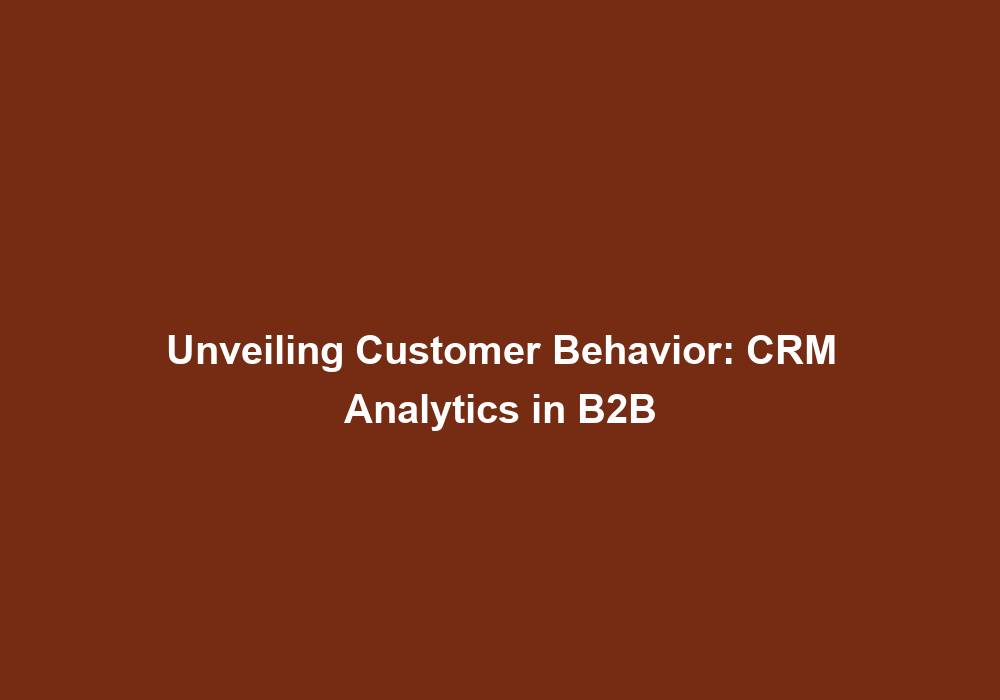In today’s highly competitive business landscape, understanding customer behavior is critical for the growth and success of any company. This is particularly true in the realm of B2B (Business-to-Business) relationships, where effective Customer Relationship Management (CRM) strategies play a pivotal role. In this article, we will delve into the importance of analyzing customer behavior in a B2B context and explore how CRM can facilitate this process.
Why Analyzing Customer Behavior Matters in B2B
Analyzing customer behavior in the B2B context holds significant importance for several reasons:
-
Personalization: By analyzing customer behavior, businesses can gain insights into individual preferences, needs, and buying patterns. This level of personalization allows companies to tailor their offerings to meet the specific requirements of each customer, leading to enhanced customer experience, fostered loyalty, and ultimately driving growth.
-
Identifying Opportunities: Understanding customer behavior enables businesses to identify untapped opportunities within their customer base. By analyzing data, such as purchasing history and behavior patterns, companies can uncover opportunities for upselling or cross-selling. This not only increases revenue but also strengthens customer relationships by offering additional value.
-
Predictive Analytics: Analyzing customer behavior empowers businesses to leverage data-driven insights to forecast future trends, anticipate customer needs, and make informed business decisions. By proactively identifying patterns and trends, companies can stay ahead of the competition, ensuring long-term success in the dynamic B2B landscape.
Leveraging CRM for Analyzing Customer Behavior
CRM systems serve as powerful tools for collecting, organizing, and analyzing customer data. When applied in a B2B context, businesses can effectively track and analyze customer behavior, gaining valuable insights for strategic decision-making. Here’s how you can leverage CRM for analyzing customer behavior:
1. Data Collection and Integration
Integrate your CRM system with various data sources, such as your website, social media platforms, and marketing automation tools. This ensures a seamless flow of customer data into your CRM, providing a holistic view of customer behavior. By aggregating data from multiple touchpoints, businesses can gain a comprehensive understanding of customer interactions and preferences.
2. Customer Segmentation
Segmenting your customers based on different characteristics, such as industry, company size, or purchase history, allows you to analyze behavior patterns within specific groups. This segmentation facilitates targeted marketing campaigns and personalized customer experiences. By tailoring your messaging and offerings to specific segments, you can effectively address their unique needs and preferences, leading to higher engagement and conversion rates.
3. Tracking and Analyzing Interactions
Utilize your CRM system to track and analyze customer interactions across various touchpoints, including emails, phone calls, website visits, and social media interactions. This data provides valuable insights into customer preferences, pain points, and engagement levels. By understanding how customers engage with your brand, you can optimize their journey, identify areas for improvement, and provide a seamless experience across all channels.
4. Creating Customer Profiles
Build comprehensive customer profiles within your CRM system, including demographic information, purchase history, preferences, and communication records. These profiles enable you to understand customer behavior on an individual level and tailor your interactions accordingly. By having a complete view of each customer, you can provide personalized recommendations, offer relevant content, and anticipate their needs, fostering stronger relationships and customer loyalty.
5. Implementing Lead Scoring
Utilize lead scoring models in your CRM to assign scores to leads based on their behavior, such as website visits, content downloads, or email opens. This helps prioritize leads and focus efforts on those most likely to convert, improving sales efficiency. By identifying high-value leads, you can allocate your resources effectively and increase conversion rates, resulting in higher revenue and business growth.
6. Utilizing Predictive Analytics
Leverage advanced analytics and predictive modeling tools within your CRM to forecast customer behavior, such as likelihood to churn, purchase frequency, or average order value. These predictions enable you to proactively address customer needs and identify growth opportunities. By understanding future trends and behaviors, you can tailor your strategies, develop targeted marketing campaigns, and deliver personalized experiences that resonate with your customers, driving long-term success.
7. Continuous Monitoring and Improvement
Regularly review and analyze the data collected through your CRM system. Use this information to refine your strategies, personalize your offerings, and optimize the customer experience. Continuously adapting based on customer behavior ensures long-term growth and success. By monitoring customer interactions, feedback, and preferences, businesses can stay agile and responsive, making data-driven decisions that enhance customer satisfaction and drive business growth.
In conclusion, analyzing customer behavior in a B2B context is essential for driving growth and maintaining a competitive edge. By leveraging CRM systems, businesses can effectively collect, organize, and analyze customer data, gaining valuable insights for strategic decision-making. Through personalized marketing efforts, predictive analytics, and continuous improvement, companies can foster strong customer relationships and achieve long-term success in today’s dynamic business environment.

This is such a relevant topic, and I appreciate how you’ve highlighted the critical nature of understanding customer behavior in the B2B space. In my own experience working in B2B sales and marketing, I’ve seen firsthand how crucial it is to not just collect data but to analyze it meaningfully to derive actionable insights.
It’s great to hear your thoughts on this topic. Your firsthand experience in B2B sales and marketing really strikes a chord. The landscape is so dynamic, and understanding customer behavior isn’t just a nice-to-have; it’s essential for meaningful relationships and sustained success.